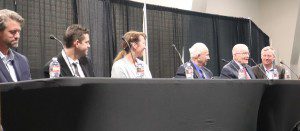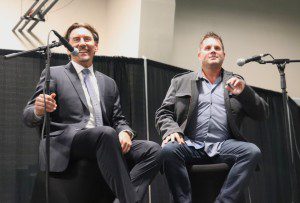LANCASTER, Calif.–Celebrating 75 Years of Breaking Barriers over America’s Aerospace Valley, the Flight Test Historical Foundation’s 2022 Gathering of Eagles probed the possibilities of what awaits humanity over the horizon, unknown hidden barriers, and the external wild-card influences of art, media and even science fiction in shaping the future of air and space technologies.
Encouraged by the rapid growth of private and public air and space launch organizations, the Flight Test Historical Foundation challenged past, present and most recent experts to explore three related matters for discussion, “Where we’ve been, where we’re going, and how do we get there?”
Starting with current events that suggest “Where we’re going” is most likely to be out of this world, the Edwards FTHF assembled the panel of experts from SpaceX, Blue Origin, Virgin Orbit, the U.S. Air Force and NASA, including veteran astronauts and test pilots.
That breakthrough created opportunity to widen public support for aerospace exploration by energizing popular imagination, expanding science, technology, engineering, arts and math programs in education, and seeking creativity from science fiction.
Up popped Gathering of Eagles Honorary Chairman Eugene Wesley Roddenberry, Jr. whose family name in the star-studded firmament of Hollywood attracted first timers among ticket buyers for the Nov. 12 banquet at the fairgrounds in Lancaster.
More importantly, the CEO of Roddenberry Enterprises and Producer of Star Trek: Discovery, Star Trek: Picard, and Star Trek: Lower Decks, engaged in a lively one-on-one interview with Emcee Bill “Evil” Gray, chief pilot at the USAF Test Pilot School at Edwards AFB.

The Q&A exchange, including the junior Rodenberry’s recollections of his father’s historic launch of the 1960s Star Trek TV series and the following wave of big budget feature films, set the mood and message for a thoughtful and out-of-the-ordinary aerospace panel discussion.
Times and fashions in the real world of aerospace research, like the acres of polyester uniforms worn by Capt. James T. Kirk’s Enterprise crew, have improved after half a century’s experience, and subtle mutual influences.
Comparing notes on changes, creative people on the back lots in Hollywood and the flightlines at Mojave and Edwards are finding inspiration from emulation. In one instance, an observed change in the elevation of engine pods to improve flight performance on an aircraft occasioned an equal readjustment on Starship Enterprise. Another case of life and art imitating one another to some advantage.
That revelation, along with news that many in the crowd at the Edwards AFB Air Show and Open House mistook a simulated replica of a decades old Lockheed Dark Star as a cutting-edge research aircraft stimulated serious and thoughtful discussion on public perceptions about flight testing advancements then, now and tomorrow.
Eagle Honoree and Panelist retired Air Force Col. Pam Melroy, test pilot, Space Shuttle astronaut and currently NASA Deputy Administrator, took part in the program by video link, commenting that in the beginning of the Space Program, all astronauts were first military test pilots.
Panelists agreed everyone involved in air and space development is standing on the shoulders of giants who came before them.
There was serious discussion about levels of risks incurred in flight testing. All agreed the first flight test of any vehicle puts the pilot at greater risk of death or injury. As Astronaut “Deke” Slayton famously advised a space shuttle orbiter crew. “About 90 percent of your risk in a total program comes with a first flight. There is no nice in-between milestone. You have to bite it all in one chunk.”
Eagle Honoree/Panelist Fred W. Haise, Jr., Lunar Module Pilot on the ill-fated Apollo 13 lunar mission, spoke of his personal experience with a risk concept voiced by a NASA administrator: “I’m not worried over any of the problems we have worried about. They’re in good shape. The things that you have to be careful about are the unknowns, things that have never happened before. A new engineering gremlin could crawl out of the woodwork, one nobody could have predicted.”
Haise, who came late to the Apollo program, said he was torn between staying at Edwards to fly the X-17 and becoming an Apollo astronaut, so he consulted with Neil Armstrong, who advised, “I’d sit in lots of meetings, sitting in simulators and not getting to fly much.” But “the Moon was exciting. Haise later commanded Space Shuttle Orbiter Enterprise.
Panelist Kelly Latimer, Virgin Galactic test pilot and flight test director, said she was motivated to fly by watching Apollo launches on TV and didn’t think about being an astronaut until the first Space Shuttle launch, which she saw as “the beginning of the next Golden Age” in aerospace.
For Todd C. “Leif” Ericson, 2022 Eagle Honoree and panelist, the past space experience is prelude to his role as mission director for Polaris Dawn, the first in a series of three space missions culminating in the first human flight aboard SpaceX Starship, the vehicle that will take humankind back to the Moon and later to Mars. Scheduled to launch in March 2023, Polaris Dawn is intended to accomplish record-high earth orbit and the first civilian Extra Vehicular Activity (EVA).
Each of the panelists, including: Jared “Rook” Isaacman, founder and CEO of Shift 4 Commander Polaris Dawn; Donald L. Mallick, retired test pilot and former Deputy Chief Director of NASA Dryden (now Armstrong); and Wesley Ryan Persall, pilot and flight test engineer for the Space Ship Company, Virgin Galactic, Scaled Composites, and Blue Origin, weighed in with the others on the closing and vital questions of whether automated systems should replace flight crews, and why human exploration of space is even necessary.
The panel responses to both issues were united in favor of retaining highly trained crews and to continue space exploration to both improve the quality of life on Earth and to protect this planet from otherwise inevitable destruction by comet or meteor impacts.
Fully programmed and automated flight control systems are limited to responding to known or predictable failures, whereas test pilots are trained and attuned to respond to any abnormality in flight conditions. FTHF Director of Education and Community Outreach Lisa Brown summed up the automaton question with another question: “How do you build a system to fix a problem you never had?”
Because of the size, scope and cost/benefit questions, panelist agreed the cost of the mission would have to enjoy either enormous national support or an international cooperative focus.
As to thoughts about following the Star Trek mission profile: “To explore strange new worlds, to seek out new life and new civilizations, to boldly go where no man has gone before.”

Expert advice: Patience. Eight months to get to Mars is too slow, and because of delays in getting food, water and other supplies, we’d have to operate with a minimum staff until we reach Warp 1.
(Whispered from the man sitting across the table) “That would be the guy from the movie, The Martian.” All-around mechanic and science genius who also makes water and grows potatoes.” Start recruiting in the Aerospace Valley, home of many of the smartest people on the planet.

